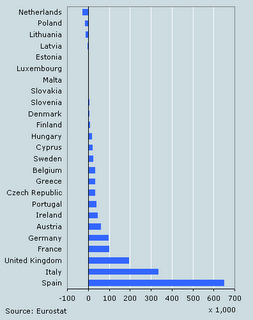Last month,
The Globe and Mail of Toronto published a series of five reports by Graeme Smith,
"Russia Shrinks", devoted to an examination of some of the demographic dynamics at work in the present Russian Federation: the high death rate, the suspicions of Chinese immigration, most worryingly the growth of violent racist youth gangs and paramilitaries. Smith's report of the 25th, the article
"Tensions rise in Lenin's hometown" was particularly interesting, examining the growth of Christian-Muslim tensions across Russia through the prism of events in
Ulyvanosk Oblast.
Abdul Karim, 26, knelt on the thick carpets of the mosque after evening prayers and described how his Russian neighbours are getting interested in the previously obscure study of demographics.
"They know the number of non-Christians is increasing," Mr. Karim said. "They're afraid Muslims will populate the whole country. Muslim families have three or four children. Russians have one. The math is simple. Naturally, they're afraid."
Russia is shrinking. Demographers predict the country will lose almost a third of its population in the next half-century. But some minorities, most notably the Muslims, are defying the trend -- and their flourishing numbers have revived ancient fears among the ethnic Russians about being overrun.
Russia doesn't officially count its religious minorities, but estimates of the country's Muslims range from 14 million to 23 million, or 10 to 16 per cent of the population. Despite the imprecise numbers, it's generally accepted the figure is growing quickly. Fifteen years ago, Russia had about 300 mosques; today, there are at least 8,000.Smith goes on to observe that in Ulyanovsk Oblast, even as the total population has shrunk the Tatar Muslim population has grown sharply to reach 12% of the province's total population. He fits this into a general and growing hostility towards Muslims in Russia, precipitated by the bloody wars in Chechnya and exacerbated by the fact that Muslim populations in Russia are growing where non-Muslim populations are shrinking. Islam is newly visible in Russia, and this disturbs many. American observer Paul Goble has gone so far as to
predict that Russia will become a Muslim-majority country,
pointing out Russia's Muslim population has increased by 40% and claiming that anywhere from 2.5 million to 3.5 million Muslims now live in Moscow.
Gobel and others are quite correct in noting that Islam in the Russian Federation has become more prominent than ever before. However, contrary to what some people might believe,
Islam in Russia has a long presence, extending at least as far back as the conquest of the regions of the Middle Volga in the 16th century, which brought the
Tatars and related Turkic peoples on the Middle Volga into the Russian state. In the 18th and 19th centuries, Russian conquests in the
North Caucasus brought the Muslim peoples of this region--Dagestanis, Circassians, Chechens, Ingush, and others--into the Russian state. Further afield, the independent states of Central Asia and Azerbaijan were brought into the Russian state as part of the same imperialist push that incorporated the North Caucasus. Total estimates on the size of Russia's Muslim population vary substantially, ranging from a low of
5% who describe themselves as practising Muslims to
17% who are of Muslim background. Suffice it to say that Russia's Muslim community is of much older vintage than the Muslim communities of other European countries, and that it is both absolutely and relatively much larger than any found in the European Union. If anything, the collapse of the Soviet Union has left Moscow with many fewer Muslims under its rule than it had for generations; if, as
some suggest, the North Caucasian republics are allowed to drift away from Russia on the model of France's withdrawal from Algeria, the numbers will at least stabilize if they don't drop still further.
Will Russia be Islamized as the population of ethnic Russians shrinks while the Muslim populations grow? This depends on what one means by "Islamize." Certainly the profile of Muslims in Russia is going to increase sharply, as it has since the 1980s when the Muslim populations of what was then the former Soviet Union began to oppose the forced secularization and Russification of the Communist era. It would
have to have risen--the sharp growth in the number of mosques has to be seen in the context of the general revival of religion in post-Communist Russia. Further, the fact that the Muslim population of the Russian heartland is growing sharply has to be seen in light of the fact that this area is not only richer than the Muslim areas of the North Caucasus, itself one of the
poorest regions of the Russian Federation, but that the Russian heartland's relative wealth makes it a
magnet for immigrants from across the former Soviet space and beyond. People from
Kyrgyzstan are as likely to migrate to the Russian Federation as people from
Moldova; life in isolated post-Soviet countries is equally hard regardless of whether the religion of the majority population is Islam. Too, it's worth noting that Muslim-majority former Soviet republics all exhibit TFRs lower than those exhibited in North America or Australasia in those continent's post-Second World War baby booms, often much lower; Soviet rule really did accelerate the demographic modernization of these areas.
Valery Tishkov and Valery Stepanov took an invaluable look at the evolution of the Russian population in their
analysis of the 2002 Russian census. They noted that "[t]he overall number of Russians decreased by 3%, and their share in the country's population fell by 2%" owing to the aging of the Russian population, but further noted that this overall tendency towards population shrinkage was substantially compensated by the immigration of Slavs and by the assimilation of such ethnic minorities like Russia's Ukrainians, Chuvash, Mordovians, and Belarusians. Russia's Muslim populations did resist the tendency to assimilate somewhat: The country's substantial Tatar, Bashkir, and (surprisingly) Chechen populations did grow somewhat through natural increase, while immigration was responsible for the sharp growth of Kazakhs and Azeris. The Muslim peoples of the Russian Federation are only somewhat behind their non-Muslim counterparts in the demographic transition; as Nicholas Eberstadt noted in a September 2004 analysis (
"The Russian Federation at the Dawn of the Twenty-first Century: Trapped in a Demographic Straitjacket", PDF format), only the republics of Ingushetia and Dagestan seem to be at replacement levels of fertility. Even assuming that out-migration from Muslim-majority areas has artificially depressed measured fertility, Russian Muslims aren't having that many kids. If the Tatar women of Ulyanovsk really
are all having three or four children, they're decidedly anomalous.
None of this means that the Russian population of 2050 is not going to be more Muslim in origins than the Russian population now. It certainly will be: Russian and Eurasian Muslims might be well advanced in the demographic transition, but population momentum inside the Russian Federation and migration from the Russian near abroad is going to push the total proportion up. I remain skeptical, given low rates of religious practice, high rates of intermarriage and assimilation, and the nature of Russia's Muslim community as an aggregate of multiple diasporas, that most of the Russian population is going to be made up of practising Muslims as
some Russian Muslims predict. Like most former empires, Russia is a pretty effective melting pot: Even
Tatarstan's relatively successful nation-building is weakened by the dispersal of most Tatars outside of Tatarstan and by the relatively high rates of assimilation inside that autonomous republic. Besides, given the
apparent ascendancy of the ideology of Eurasianism in Russia, it's not at all obvious that a more strongly Muslim population will necessarily change that much, at least so long as obvious provocations are avoided on all sides and the full assimilation of Russian Muslims as equal citizens made possible.
Unfortunately, as Dora Apel
warns at Open Democracy, the ascendancy of xenophobic and explicitly anti-Muslim ideologies in Russia and the Islamization of the Chechnya issue threaten to do just this. It goes without saying that this is a terrible mistake. Russia's population is projected to decline sharply in the generations to come, even with the demographic dynamism lent it by its Muslim populations. Especially with the prospect of western and central Europe offering better living and working conditions for potential migrants, Russia just cannot afford to exclude a large and growing share of its population. Frighteningly, it may do just that with obvious calamitous consequences for everyone involved. Here's to hoping that the best-case scenarios materialize.





